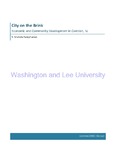| dc.rights.license | In Copyright | en_US |
| dc.creator | Farquharson, V. Michele | |
| dc.date.accessioned | 2013-11-22T15:41:04Z | |
| dc.date.available | 2013-11-22T15:41:04Z | |
| dc.date.created | 2011 | |
| dc.identifier | WLURG38_Farquharson_POV_2011_wm | |
| dc.identifier.uri | http://hdl.handle.net/11021/24134 | |
| dc.description | Capstone; [FULL-TEXT FREELY AVAILABLE ONLINE] | en_US |
| dc.description | V. Michele Farquharson is a member of the Class of 2011 of Washington and Lee University. | en_US |
| dc.description.abstract | Today people know Camden, NJ as one of the poorest and most dangerous cities in America. It has a population of 80,000 people with an unemployment rate of 10.1% and for those over the age of 25 only 50% graduated from high school.1 Of those who work their median income is $23,421, which puts 36% of Camden residents and 45% of Camden children in poverty.2 But how did Camden reach this state? How did decades of disinvestment go unnoticed until “on November 21, 2005, Camden was deemed the most dangerous city in America for the second consecutive year,” with a murder rate “over 10 times the national rate” and a “rate of robbery in 2004 [that] was 30% higher than the #2 city.”3
The Beginning Old Camden's industrial and commercial sectors survived two World Wars, the Great Depression, and it was not until the 1970s that Camden's steady decline became a rapid dive. Why then did Camden fall harder than other industrial cities? Disinvestment affected most cities across America, as did white-flight, but why did Camden never resurface? [From introductory section] | en_US |
| dc.description.statementofresponsibility | Michele Farquharson | |
| dc.format.extent | 32 pages | en_US |
| dc.language.iso | en_US | en_US |
| dc.rights | This material is made available for use in research, teaching, and private study, pursuant to U.S. Copyright law. The user assumes full responsibility for any use of the materials, including but not limited to, infringement of copyright and publication rights of reproduced materials. Any materials used should be fully credited with the source. | en_US |
| dc.rights.uri | http://rightsstatements.org/vocab/InC/1.0/ | en_US |
| dc.subject.other | Washington and Lee University, Shepherd Poverty Program | en_US |
| dc.title | City on the Brink: Economic and Community Development in Camden, NJ | en_US |
| dc.type | Text | en_US |
| dcterms.isPartOf | RG38 - Student Papers | |
| dc.rights.holder | Farquharson, V. Michele | |
| dc.subject.fast | New Jersey -- Camden | en_US |
| dc.subject.fast | Community development | en_US |
| dc.subject.fast | Economic development | en_US |
| dc.subject.fast | Suburbs -- Growth | en_US |
| dc.subject.fast | Community development, Urban -- Economic aspects | en_US |
| dc.subject.fast | Urban Land Institute | en_US |
| local.department | Shepherd Poverty Program | en_US |
| local.scholarshiptype | Capstone | en_US |
